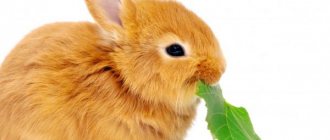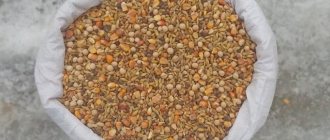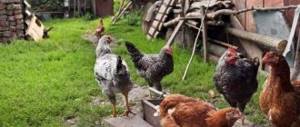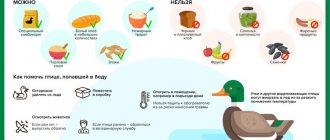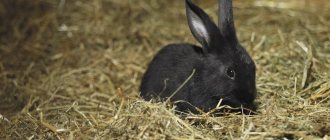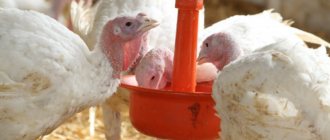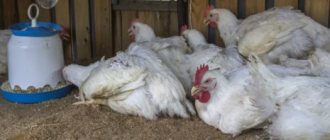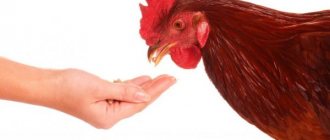What should you absolutely not feed chickens, and what should you give with caution?
I heard that something about the potato broth is not right for chickens.
It seems to be poisonous to them. Is it so? Then what about mash, drain the water? What else should you not give to chickens at all, and what is not advisable? Poisonous potatoes, or rather skins that are green (unripe) or improperly stored potatoes. If the potato has green areas of skin. So, in these green areas the poison solanine is concentrated, which is dangerous not only for animals and birds, but also for people! But it is enough to cut off this green peel along with the pulp. And then you can safely use it as food and feed. And when such tubers are cooked, this solanine goes into the water, but not all of it. Files: 539px-aardappel_gytsum.jpg 1258036226_green-potato-1.jpg
Thank you, but how dangerous is it? Just ate green potatoes and bye? Or is it not so categorical? Should cabbage be limited or can it be free?
The solanine content in green tops reaches 0.25%, in young sprouts up to 0.5%, in flowers 0.7%, in fruits (potato berries that ripen by the end of summer) up to 1%. A lot of it accumulates in green or sprouting tubers (up to 0.5%). Chickens are especially sensitive to solanine. Solanine is toxic to humans and animals even in small doses. In large doses, solanine destroys red blood cells and has a depressant effect on the central nervous system. If solanine enters the body, it causes dehydration, fever, and convulsions. For a weakened body, all this can result in death. No heat treatment will help neutralize the poison. Cabbage has nothing to do with it)) Solanine is a plant poison of the Solanaceae family, to which potatoes also belong.
Thank you)) that means if it hits a little, it’s not scary, well, it’s 1% of the total mass.. but it’s better to avoid getting hit completely.. I just already gave it.. I thought I’d run and take it away)))
and cabbage has nothing to do with it, it’s clear, but can you give a lot of it? isn't it harmful? I just throw in the fluffed cabbage and they peck it down to the stalk the day before..
Just for fun, I boiled the peels of oranges and tangerines and gave them to the chickens. We ate everything. Isn't it fraught with anything?
Green food
An important part of the diet of hens and chicks is fresh green grass. Birds get vitamins, minerals, and fiber from it. The supply of these substances obtained over the summer helps animals to survive the winter easily and without disease. But not all grass is beneficial: some types of plants are a threat to the bird’s body.
Such plants include:
- Black nightshade and all shoots and flowers of the nightshade family (eggplant, tomato, potato, tobacco);
- Henbane;
- Juniper;
- Belladonna;
- Elder;
- Burdock;
- Buttercup;
- Ambrosia.
You should not give tops of legumes (peas, soybeans, beans) because they cause constipation and flatulence. The controversial issue is whether it is possible to give chickens dandelion and celandine. These plants do not cause obvious changes in the body if they do not form the basis of the daily diet.
Green feed is introduced to chickens from the first day of life. It could be green onions or scalded nettles. Young nettle contains a lot of iron, manganese, zinc, copper and vitamin K; it is useful for all chickens without exception.
Clover, alfalfa, parsley, and radish tops are also good for birds; young green pine needles and tree leaves are mixed into the food.
Chickens are very fond of an ornamental plant called kochia. This fluffy bush is medicinal; medicines for people are made from it, but it also helps chickens strengthen the immune system and fight various diseases.
A balanced and proper diet is the basis for egg production, fertility and quality of chicken meat. Feed poor in nutrients leads to diseases, chickens pecking each other, their own and other people's eggs. A weakened body does not cope well with viruses, bacteria, and parasites, which is why epidemics and deaths of birds occur in the chicken coop.
Makarov Ivan Vasilievich
Hereditary poultry farmer, owner of a poultry farm, graduated from St. Petersburg State Agrarian University with honors, author of articles in specialized publications
Rules for creating a varied diet for chickens
The main rule that should be followed in a chicken diet is maximum variety, constant alternation of types of food. Of course, there are basic foods in the diet. In summer these are green feeds (up to 30%), in winter – grain, concentrated and combined feeds (up to 90%).
It is quite acceptable and even advisable to combine homemade food into a “mash”. It may include chopped fresh or dried grass, tops, vegetable peelings, cereals, grains, animal products, salt, vitamin and mineral premixes.
Compound feed
This is an ideal option, especially in winter. We have developed and produce special combined feeds for chickens and other poultry, and you can choose the optimal one from the point of view of what breed you are raising - meat or egg-laying.
In mixed feed, 60–70% are grain products, 20–30% are corn and legumes. The feed may also include berries and vegetables, bone meal, milk powder, dried grass, and vitamin and mineral supplements.
Vegetables and root vegetables
Your cockerels and hens will be happy:
- carrots;
- zucchini;
- pumpkin;
- boiled potatoes (sometimes a little);
- cucumber peelings;
- fodder beet (dosed);
- leafy greens (sorrel, salad, parsley, dill, onion, amaranth);
- green peas with pods;
- cabbage leaf;
- turnip;
- rutabaga;
- radish and radish (just a little).
Many vegetables need to be dosed, not just potatoes. In particular, this applies to “bulging” cabbage and weakening beets (including beet tops). Greens with pronounced medicinal properties or spicy ones (parsley, dill, basil, cilantro) should also be given carefully.
It is recommended to chop vegetables and their peels thoroughly, cut them into small pieces, and grate them.
Cereals
This is a kind of food “must have” for chickens. Any grains are used, even coarse barley. Millet (hulled millet grains) occupies a special place in the chicken diet. By the way, this is a very affordable product even at retail.
If you want to feed your chickens mature corn, it is best to boil it to reduce the amount of starch.
Adult chickens can also be accustomed to raw sunflower seeds, but very gradually. It is recommended to feed them with seeds during the period that is poor in terms of diet - autumn and winter, this way they prevent excessive obesity.
Grass and tops
Most grass and tops are available in the warm season. For the winter, the grass can be dried in the shade, chopped and added to the mash.
The most nutritious herbs for chickens:
- nettle;
- alfalfa;
- clover;
- wheatgrass;
- beetroot;
- meadow bluegrass;
- quinoa;
- dandelion;
- purslane, etc.
Many herbs and plants can be used to treat and prevent common avian diseases:
- lingonberry leaf;
- three-leaf watch (water trefoil);
- Dill seeds;
- bear bow;
- pine buds and needles;
- coriander;
- flax-seed;
- blue cornflower;
- valerian;
- fern;
- St. John's wort;
- cumin seed powder;
- coltsfoot;
- sagebrush.
The best way to provide grass to “non-roaming” chickens in the summer is to tie a bunch and hang it at a certain height. This way they will not trample on valuable food and at the same time will stretch their legs while extracting it.
The ideal garden tops are carrots, beets (in doses), garden weeds (euphorbia, sow thistle), but in no case nightshade tops (potatoes, tomatoes, physalis, nightshades)! It is also better not to give the peelings and fruits of these crops.
Animal products
Animal protein and calcium are very important for queens. In finished form, it is bone and animal meal, milk powder, and other factory-produced additives. Experienced amateur poultry farmers do not miss the opportunity to collect and grind egg shells to avoid mineral starvation. This way you can prevent even winter “vacation” for laying hens.
Is it possible to give bread?
The main requirement for a balanced diet for chickens is the presence of nutritional and beneficial elements such as fats, carbohydrates, minerals and vitamins. In this regard, a completely logical question arises: “Is it possible to give chickens bread?” Opinions on this matter vary greatly. The type of baking is of great importance here.
If you mix bread with bran, cottage cheese, meat, herbs and potatoes, you will get a good complete food for birds. Such food will not harm the health of chickens and will have a good effect on the level of egg production. As for fresh bread, it is not recommended to give it to birds. Such a product can adversely affect the health of the chicken and also reduce immunity.
The fact is that in chicken stomachs, fresh bread swells and turns into a dense lump. This may even lead to the death of the bird. Black varieties of bread are especially dangerous. They contain salt and yeast, and also have a high level of acidity. This composition helps to activate the fermentation mechanism, which reduces egg production.
Can any bread be given to birds? What should you not feed chickens? In no case is it recommended to give sweet buns and pastries with various fillings. This type of diet contributes to blood thickening and can lead to digestive disorders. Since white bread is also high in carbohydrates, it can only be given in the form of crackers.
But even in this form, you should not be zealous with feeding. In winter, bread can be an excellent source of energy for birds. However, if chickens are kept in cages or small enclosures, it is better not to use such food. This type of food, combined with a lack of exercise, can cause blockages in blood vessels.
Prohibited foods for chickens and chickens
Exotic fruits
The contraindication is relative: it is unknown how the bird’s body will perceive the “exotic”. So it’s better to leave yourself pineapple, kiwi and other essential oil oranges with starchy bananas.
Dairy
Chickens do not have the enzyme to digest lactose, so whole milk products, cheese, and butter are strictly excluded. Fatty fermented milk too (see above for permitted fermented milk).
Sweets
Sweets, especially flour, are only harmful to birds. Just like bread, it provokes fermentation and unfavorable changes in flora in the digestive tract of birds.
Potatoes and tops
Potatoes, as already stated, can only be boiled, ungreened and very rarely, in small quantities. It is also better not to give cleaning to chickens.
Food from the table
Of all the foods on the table, the only foods the chickens will eat are salads without dressing and vegetable soups. We also wrote above about bread crusts and all kinds of pasta. But always collect and grind the shells, especially in winter.
Other restrictions
When giving birds any food, monitor its condition. Mold, rot, dirt and debris are unacceptable. Even if nothing happens right away, unhygienic feeding and maintenance are fraught with a number of severe disorders, helminthic infestations, and even bird pestilence.
About kefir
Kefir is a product obtained from milk through fermentation.
In order to cause it, kefir starter is added to milk, which is a rather complex symbiotic mixture of two dozen microorganisms and yeast fungi. Kefir is the twin brother of yogurt, well known to health advocates. In fact, both of these products differ solely in their sourdough. At the same time, the kefir starter is much more diverse, and the final product is much richer in vitamins such as:
- A;
- D;
- K;
- E.
The living elements of kefir starter - lactic acid streptococci, acetic acid bacteria, yeast and others - feed primarily on milk sugar, lactose, and produce acids, carbon dioxide and even a small amount of alcohol.
At the same time, the lactic acid culture of the kefir starter remains alive and is contained in large quantities in the kefir itself. When consuming kefir, not only milk processing products enter the digestive tract, but also the microorganisms themselves.
Most of the bacteria die on the way to the intestine from body temperature and the aggressive effects of gastric juice, but part of the microflora still reaches the intestine and has a probiotic effect on its microflora, promoting the development of beneficial microorganisms and suppressing the proliferation of pathogenic ones.
What grass should you not feed chickens?
These are poisonous or harmful herbs, tops, branches. Of course, your feathered pets themselves can distinguish safe plants from dangerous ones. But anything can happen. Therefore, you need to be careful, especially when harvesting meadow grass for winter feeding.
You should not give chickens:
- burdock;
- cockle;
- hemlock;
- henbane;
- belladonna;
- elderberry;
- broom;
- celandine;
- hellebore;
- spotted hemlock;
- white acacia;
- juniper;
- horse chestnut
The golden general rule when choosing herbs is this: if in doubt, don’t give it. Moreover, even medicinal herbs and plants in excessive quantities will be dangerous.
So, as you can see, you can introduce many foods into your chickens’ diet. Take care of their proper nutrition, and the bird will delight you with excellent health, good weight gain and eggs, even in winter.
Greens for laying hens
The chicken should eat 120 g of feed per day. This portion is divided into morning and evening feeding. In the morning, an hour after waking up, the mash is prepared. Wet food stimulates egg production. The mash consists of cereals, vegetables, herbs, and mineral fillers. In the evening they give grain: a mixture of crushed and whole.
- Wheat and barley are useful cereals for birds. Rye is rich in protein, but not much is given to birds.
- Carrots are a useful vegetable. It is ground on a grater. It contains carotene, which improves reproductive function. Cabbage is rich in fiber. It contains many vitamins and mineral salts. The birds are given zucchini, pumpkin, and boiled potatoes.
- Chickens need grass. This is a source of vitamins. Green onions, dill, and parsley are added to the mixture. Nettle, dandelions, clover, and alfalfa are useful.
- Shell rock is installed in the chicken coop as mineral fillers. The food is mixed with eggshells and crushed shells. A little table salt is given, no more than 1 g per individual per day. It can provoke intoxication of the body.
- It is worth taking care of animal products. They are administered in the form of bone or meat meal, but not more than 5 g per day. Larger amounts of the additive cause aggression in chickens and can provoke pecking.
- Laying hens benefit from fish and fish oil. The fat is usually mixed with the feed. The fish is served as minced meat.
- For better grinding of food, birds need small pebbles. It is purchased from the manufacturer. The diameter of the stones is no more than 4 mm.
- Crushed and whole grains form the basis of the diet. It is given in 100 g. Crushed pieces are 10% more. It is part of the mash.
- The chicken receives fresh greens in summer, spring and autumn, but not more than 30 g per day. Otherwise, she may develop gastrointestinal upset. In winter, give silage or grass flour: 5 g of flour.
- In autumn and spring, birds are given carrots and pumpkin. The amount of feed is 20 g/head. In summer, the individual receives all its vitamins from green grass. Carrots can be excluded from the diet. The volume of the root crop increases in winter to 40 g.
- In winter, sunflower cake or soybean pulp, 12 g, is added to food. In summer, protein supplements are introduced if egg production decreases.
- Feed yeast is useful. For 1 head 4 g.
- More bran is given up to 10 g/bird.
- Meat and bone meal should be 5 g, but it can be replaced with minced fish, no more than 15 g/bird.
- If a shell rock is not installed in the chicken coop, then an additive containing calcium is added to the mash, at least 5 g. In the summer - 7 g/bird.
- Mashboards are made using fermented milk products, 30 g.
- Jackdaws are prescribed 1 g every 10 days.
If there is no time to prepare a diet for poultry, then purchase a combined feed. For laying hens, PC1, PC2 are shown. It is given in dry form or wet food is prepared using skim milk. If necessary, vitamin fillers “for laying hens” are added to the food. Pebbles are a must-have product for chickens: they are their “teeth.” Compound feed is administered at the same rate as other food. For chickens producing eggs and meat, the amount of feed is increased by 30%.
What you can and cannot feed chickens
Author: Chicken Ryaba
/ 25 Dec 2021 at 08:00
Good afternoon, experienced and novice poultry farmers! In this material we will tell you what you can and cannot feed laying hens and broilers. Standard and balanced feed for feeding poultry is a given. Let's not dwell on this.
How and from what wet mash is prepared - read the link, everything is quite simple.
Today we will focus on unusual products that can be given. Only personal experience. These are not recommendations - this table is for your reference.
This is a list of almost everything you can safely feed your chicken. However, all chicks and adults have their own tiny brains full of likes and dislikes. Therefore, while some chickens may run for grapes or watermelon, chickens of a different breed or character will not react at all to the offered delicacies.
Everything on this list is definitely safe to eat and worth a try!
Can you give seeds to chickens?
Today we will talk about the nuances of using sunflower seeds in chicken diets, which are rich in vitamins, healthy fats, minerals and other vital nutrients.
Today you can often hear from poultry farmers that the inclusion of seeds in the food supply is fraught with obesity in the bird. They say that this is a very high-calorie ingredient from which no benefits can be expected. Is it so? Let's understand better.
The benefit or harm of seeds is determined by the type in which they are fed. Of course, a lot depends on compliance with feeding rules. Including recommended daily allowances, combinations of seeds with certain dietary ingredients.
Regular seeds for hens and chicks
In this form, fertilizing is applicable in both meat and egg poultry farming. True, you shouldn’t abuse it. Why? Due to the high calorie content of the ingredient, this leads to obesity in the bird and, accordingly, to a deterioration in egg production or to a complete cessation of egg laying.
According to livestock specialists and veterinarians, it is more rational to refuse to give seeds to chickens under the age of 1 month.
By the way, you can often hear that it is useful to give seeds to young animals that are stunted, starting from 7 days of age. In this case, the maximum specific gravity of the additive is 5%.
Another limitation is that the seeds are crushed and the husks are removed, since, due to its difficult digestibility, it overloads the weak intestinal tract of chickens.
The percentage of the additive in the diet of pullets over the age of 30 days is 1-1.5%, of individuals that have reached physiological maturity - no more than 15%.
The optimal time to enrich the diet with seeds is autumn and winter. In other seasons, feeding fertilizer is often the cause of obesity in chickens.
By the way, autumn feeding with seed allows skinny birds to acquire a small reserve of fat, which will provide additional energy in the harsh winter.
The organic part of the seeds is represented mainly by protein (20%), tocopherol, and essential vitamins. B, A. The additive is a storehouse of potassium, calcium, phosphorus, magnesium, sodium, iron, selenium, manganese and zinc. It is easy to guess that such a composition is positively related to the productivity and health of poultry.
Roasted seeds for laying hens
Such food will not benefit any complex organism. The only good thing about it is its pleasant aroma and taste.
Frying leads to partial or complete destruction of biologically active substances, such as vitamins. Under the influence of high temperature, fats become less accessible to the gastrointestinal tract and therefore have an irritating effect on the intestinal mucosa. Of course, this is where diarrhea and dehydration come from.
By the way, sunflower was originally cultivated on the American continent. This happened 5 thousand years ago.
Advice: refuse to use seeds if you are farming in an environmentally unfavorable area. The fact is that a sunflower, like a sponge, absorbs everything that is possible and impossible - toxins, radioactive elements...
By the way, plants grown near busy transport links are saturated with lead.
What about feeding with husks?
If you decide to diversify your diet with such an ingredient, you should know that it contains very little biologically active substances. The husk is also poor in protein compounds, fats, and carbohydrates. But it is classified as a fiber supplement - the mass fraction of fiber is at least 1/2.
Feeding with such a chemical composition will be suitable for the stomach of a ruminant animal, but not for a bird.
Subscribe to site updates and our channel “Chicken” in Yandex.
See you later, colleagues! We have a lot of useful information ahead.
See modern products for poultry and livestock farmers that improve the health of pets and make our work easier.
What can you feed chickens?
Please note that at the end of the article we provide a table of what you should not feed chickens!
My favorite chicken treat of all is worms! Pay attention to the lightning speed when pecking, this is a reaction!
Yogurt is my hens' favorite food and it's great for gut health.
And in this photo, the chickens came running to enjoy kefir.
In the photo, a Wyandotte rooster is jumping for peanuts.
Wow! What is this? Can you eat this, is it tasty?
Here's a bowl of warm oatmeal, girls!
Warm oatmeal tastes even better after a big snowstorm.
Some leftover rice with vegetables.
Third place
We gave third place in our rating to beets - a product that can be given to chickens, but with caution and always in dosage. The fact is that beets are a good laxative for chickens, however, a large amount of them can cause severe diarrhea and, as a result, depression in the general condition of the bird. In addition, beets have a pronounced coloring effect and can color a bird’s cloaca bright red. And this is fraught with pecking and cannibalism among chickens - a phenomenon, unfortunately, not uncommon among chicken flocks. Therefore, be very careful with beets and give them the best fodder type.
Remember that how and what you feed the bird determines not only its health, but also the taste and quality of its eggs and meat, and the breeder is primarily interested in this. In addition to the listed chicken stop products, you should also avoid the following:
- Peel from orange or other citrus fruits;
- It is also better not to give black bread, unlike white bread;
- It is better to abstain from celandine or give it in small quantities; also do not give the bird ragweed;
- Too sweet or salty food waste is also not suitable for poultry feed, the fact is that the digestive systems of humans and chickens are very different, so they are not able to adequately, without consequences, perceive human food with pronounced taste qualities.
In what quantity and how are bananas given to rabbits?
Before treating your pet to a sweet banana, rabbit breeders should remember that the fruit does not serve as the main food in the diet. It is given only as a treat, in small portions. The fruits are offered in different varieties.
Fresh
Rabbit breeders willingly offer the fruit in this form to their pet. Make sure that the pulp is not overripe, otherwise it will cause diarrhea in the rabbit. It should be included in the menu in small doses, monitoring the pet’s health condition. An eared pet must be active and have a good appetite.
The delicacy is pre-finely chopped. Large individuals are given no more than 40 grams of fresh fruit. If there are uneaten pieces left in the cage, they are removed, as the pulp quickly deteriorates, which will provoke a food reflux in the furry animal.
Dimensions of hay barns for rabbits and how to make a feeder with your own handsRead
Zoologists recommend giving exotic fruit no more than four times a month. Feeding is carried out only in the morning; it is not advisable to offer the rabbit a banana at night.
Dried
Factory feeds contain a mixture of grains, nuts, dried fruits and vegetables. This diet is not recommended for herbivores. The product contains a high content of fats, which negatively affects the condition of the pet’s internal organs.
Expert opinion
Zarechny Maxim Valerievich
Agronomist with 12 years of experience. Our best country expert.
Ask a Question
Dried banana in limited quantities has a positive effect on the functioning of the brain, digestive and cardiovascular systems, and immunity.
Dried fruit contains a sufficient amount of vitamins, minerals, microelements, and fiber. Unlike fresh fruit, it is convenient to store when dried; it does not lose its beneficial qualities for a long time. Dried slices are quite hard, such a treat is good for your pet’s teeth.
Dried fruit has a higher sugar content than fresh fruit. Therefore, it is worth limiting the time and amount of fruit your pet eats. It is enough to give one piece no more than once or twice a month.
Application
Bananas in medicine
For its properties, the product is used in the treatment of certain diseases.
For diabetes mellitus, it is recommended to eat green fruits or yellow ones, but boiled. If you lack sugar, you can eat ripe fruit, which has a glycemic index of 50 units. Banana is beneficial for pancreatitis, because. envelops the walls of the stomach and regulates gastrointestinal processes. In the treatment of gastritis, thanks to the properties of bananas, inflammatory processes are reduced. If you have problems with the intestines, they are also recommended for use, because they promote bowel movement. Regular use helps with constipation, because
Helps soften bowel movements. In case of gout, they influence inflammatory processes and relieve pain. During an exacerbation of colitis, bananas are added to the diet, for example, small ones promise as much benefit as large ones. Fruits remove waste and toxins, and therefore are incredibly healing for the liver. Unpleasant sensations during exacerbation of hemorrhoids constantly haunt the patient; if fruits are added to the diet, then problems in the functioning of the stomach and intestines will be eliminated and the exacerbation will pass more calmly. Even with cholecystitis, you can eat berries, but this should be done carefully and in small quantities.
Bananas in cosmetology
Banana essential oil also has medicinal properties, which is used as an additional ingredient in face cream. It provides vitamins, perfectly softens the skin, eliminates dryness, flaking and dandruff, and reduces scalp oiliness. In addition, it is used to lubricate dry elbows and rough skin on the heels; it softens the skin and makes it tender and soft. The oil also eliminates nail brittleness, strengthening the plate and making it dense and uniform.
Essential little banana. Photo: sc01.alicdn.com
Folk remedies with banana
- Hair mask from 1 tbsp. l. honey and lemon juice, as well as crushed banana, applied to the hair roots for several hours, will saturate with vitamins, strengthen the hair follicles and reduce oiliness.
- You can make a face mask from a banana; it will be especially useful for those who have very dry skin. To do this you need to take 2 tsp. fat cottage cheese, 1 tsp. pulp, yolk and 1 tsp. camphor oil, mix until smooth and apply to skin for 30 minutes, then rinse with warm water. As a result, the skin will become soft, become fresh, nourished, fine wrinkles will be smoothed out, and dryness will disappear.
- There is a folk recipe with a banana for coughs; for this you can mix half a teaspoon of honey, a glass of boiling water and crushed fruit, let it brew and drink half a glass warm every 2 hours. Children can prepare another recipe - crushed fruit, 2 tsp. cocoa, honey and a glass of hot milk, mix and drink hot in small sips.
Bananas in cooking
The product is actively added to smoothies, cocktails, fillings are made for pancakes and muffins are baked with them, in addition, they are prepared as an independent dish, for example, fried or baked.
This is interesting! To wake up in the morning, you can take a ripe banana, a glass of coffee and a glass of milk, mix in a blender, and a drink full of benefits is ready to drink.
Benefits of bananas
Why bananas are good for the human body:
Due to the low fat content, the calorie content of bananas is low, and this is useful for those who have problems with the gastrointestinal tract, but caution must be exercised; its harm is in the high glucose content, which leads to a feeling of hunger. The beneficial properties apply to the entire banana without exception. The pulp is a dietary food and is indicated in the treatment of stomach ulcers and diseases of the oral cavity.
An infusion of flowers helps with bronchitis and diabetes, the juice of the stems has an anticonvulsant effect. Even banana peel has beneficial properties, it helps with burns and abscesses, and is also used as fertilizer for indoor plants. In addition, bananas produce an antioxidant that fights cancer cells, but can harm the body if, for example, they are consumed before meals. Thanks to fiber and microelements, fruits are good for the heart, because. consuming them reduces the risk of stroke and other heart diseases. In addition, the product regulates blood pressure, heart rate and brain activity. Regular consumption regulates glucose levels, prevents anemia, and maintains the health of the skeletal system due to the presence of potassium in its composition, which slows down the leaching of calcium. Thanks to the calming effect, irritation, fatigue and depression pass faster due to vitamin B6, which stimulates the production of serotonin. Provides kidney health thanks to its potassium content, which regulates water-salt balance.
Interesting! 100 g of banana contains no cholesterol and only 0.1 g of saturated fatty acids.
The benefits of bananas for women
Bananas are extremely useful, although they can be harmful, for a woman’s body. Constant use will improve the condition of the skin, remove toxins and waste, increase the production of oxytocin, reduce pain during menstruation and reduce the number of migraines.
The benefit for pregnant women is that they contain a lot of vitamin B6 and minerals, they fight heartburn, constipation, bad mood, insomnia, and the harm occurs with excess weight and individual intolerance. Therefore, consultation with a doctor is necessary.
Benefits of bananas for men
Bananas also bring benefits and harm to the male body. For those who lead an active lifestyle, this product is extremely important, because it increases muscle regeneration, improves the condition of ligaments and fills the body with energy.
The fruit relieves swelling, fights inflammation in the mouth, and improves stomach function. Men with obesity, blood problems, sleep disorders and a tendency to allergies should be careful.
The fruit is also considered an excellent aphrodisiac. It has been proven that eating bananas improves sexual performance: erection, prolonged sexual intercourse.
Benefits of bananas for children
In order to benefit from bananas, it is necessary to gradually introduce it into the menu for children. It can be given starting from six months, because it increases immunity, improves memory, attention, sleep and is involved in the formation of skeletal and muscle systems. The harm of bananas for children is obvious only in the case of an allergic reaction, which, however, can also begin in an adult. Interesting fact! What the body lacks if you want bananas is potassium, which supports the functioning of the heart and the whole body
Interesting fact! What the body lacks if you want bananas is potassium, which supports the functioning of the heart and the whole body.

